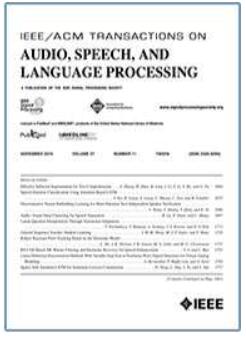PE-Wav2vec: A Prosody-Enhanced Speech Model for Self-Supervised Prosody Learning in TTS
IF 5.1
2区 计算机科学
Q1 ACOUSTICS
IEEE/ACM Transactions on Audio, Speech, and Language Processing
Pub Date : 2024-08-23
DOI:10.1109/TASLP.2024.3449148
引用次数: 0
Abstract
This paper investigates leveraging large-scale untranscribed speech data to enhance the prosody modelling capability ofPE-wav2vec:用于 TTS 中自监督前奏学习的前奏增强型语音模型
本文研究了如何利用大规模非转录语音数据来增强文本到语音(TTS)模型的前音建模能力。在自监督语音模型 wav2vec 2.0 的基础上,通过引入前奏学习,提出了前奏增强型 wav2vec(PE-wav2vec)。具体来说,前音学习是通过对 wav2vec 2.0 架构中的初始变换器块应用线性预测编码(LPC)残差信号的监督来实现的。用 PE-wav2vec 模型的初始变换器块提取的嵌入向量可用作语音语篇中相应帧的前音表示。为了将 PE-wav2vec 表示法应用于 TTS,在 FastSpeech 2 的基础上设计了一个名为 "基于自监督学习前音表示法(S4LPR)的语音合成模型 "的声学模型。实验结果表明,与 vanilla wav2vec 2.0 模型相比,所提出的 PE-wav2vec 模型能提供更丰富的语音前体描述。此外,与基线模型相比,使用 PE-wav2vec 表示法的 S4LPR 模型能有效提高合成语音的主观自然度,减少客观失真。
本文章由计算机程序翻译,如有差异,请以英文原文为准。
求助全文
约1分钟内获得全文
求助全文
来源期刊

IEEE/ACM Transactions on Audio, Speech, and Language Processing
ACOUSTICS-ENGINEERING, ELECTRICAL & ELECTRONIC
CiteScore
11.30
自引率
11.10%
发文量
217
期刊介绍:
The IEEE/ACM Transactions on Audio, Speech, and Language Processing covers audio, speech and language processing and the sciences that support them. In audio processing: transducers, room acoustics, active sound control, human audition, analysis/synthesis/coding of music, and consumer audio. In speech processing: areas such as speech analysis, synthesis, coding, speech and speaker recognition, speech production and perception, and speech enhancement. In language processing: speech and text analysis, understanding, generation, dialog management, translation, summarization, question answering and document indexing and retrieval, as well as general language modeling.
 求助内容:
求助内容: 应助结果提醒方式:
应助结果提醒方式:


